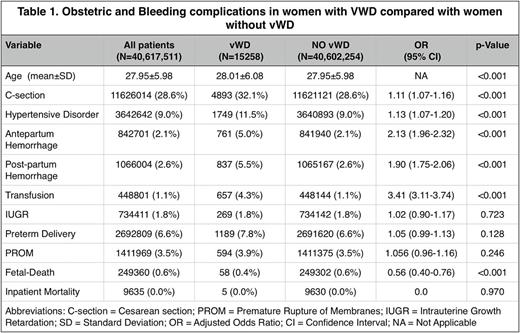Abstract
Introduction: Prior studies suggest that women with Von Willebrand Disease(vWD) are at an increased risk of bleeding and obstetric complications during pregnancy. This study was undertaken to determine the risk of complications occurring during pregnancy for women with vWD using Nationwide Inpatient Sample (NIS) Database from the Healthcare Cost and Utilization Project of the Agency for Healthcare Research and Quality(AHRQ).
Method: We queried the NIS database for the years 2003- 2011, to identify all pregnancy-related discharges for women between 18-50 years of age. The pregnancy-related discharge records were identified by using the International Classification of Diseases Ninth Revision (ICD-9) and were classified as to whether they were an admission during pregnancy or postpartum. ICD 9 code used for vWD was 286.4. Binary logistic regression was used to compute adjusted odds ratio with 95% confidence interval(CI) after adjusting for potential confounders such as age, race, primary payer, hospital location, teaching status and patient comorbidities.
Results: There were 15,258 pregnant women with vWD among 40,617,511 pregnancy related discharges. Women with vWD were slightly older than those without (28.01±6.08 vs 27.95±5.98, p<0.001). Pregnant women with vWD were more likely to have cesarean section (32.1% vs 28.6%, OR 1.11(CI 1.07-1.16), p<0.001), hypertensive disorder (11.5% vs 9.0%, OR 1.13 (CI 1.07-1.20), p<0.001), antepartum hemorrhage (5% vs 2.1%, OR 2.13(CI 1.96-2.32), p<0.001), postpartum hemorrhage (5.5% vs 2.6%, OR 1.90(CI 1.75-2.06), p<0.001) and transfusion (4.3% vs 1.1%, OR 3.41(CI 3.11-3.74), p<0.001). Conversely there was increased risk of fetal death in women without VWD. Five of the 15,258 pregnant women with vWD died during hospitalization. The frequencies of the above outcomes with adjusted Odds Ratio are reported in Table 1.
Conclusion: Pregnant women with vWD have increased risk of bleeding complications, hypertensive disorder and need of transfusion. High incidence of cesarean section in patients with vWD could likely be explained by planned cesarean section in this high-risk group. There was no increased risk of fetal or maternal mortality in women with vWD. This cross sectional study would help to understand the magnitude of these complications so that they could be managed optimally during antenatal period. Further prospective studies are needed to confirm these findings.
No relevant conflicts of interest to declare.
Author notes
Asterisk with author names denotes non-ASH members.


This feature is available to Subscribers Only
Sign In or Create an Account Close Modal